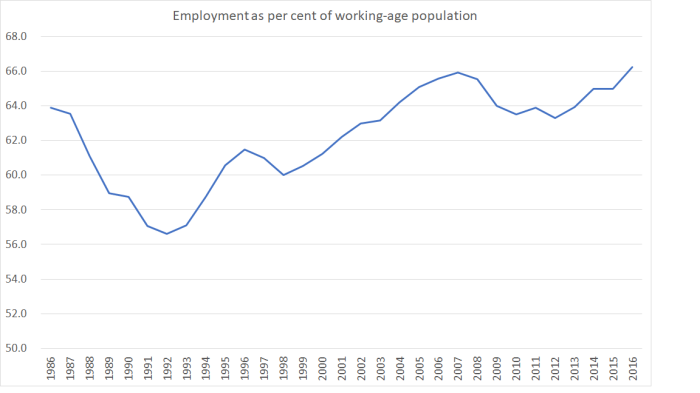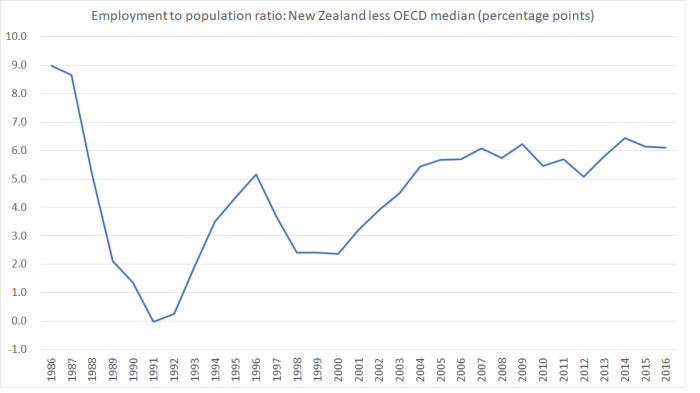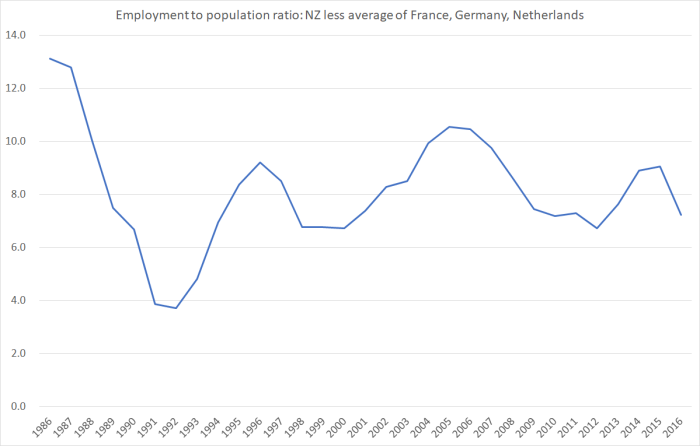With 30 seconds thought it is pretty obvious that if the least productive 10 per cent of our workforce simply dropped out and stayed home, then across the whole economy average GDP per hour worked would increase, all else equal. All else equal, the productivity of any particular individual still employed wouldn’t change – in practice it might well, as someone would still have to do the filing or the cleaning – but the average would.
So far, so uncontroversial. No one thinks it would be a sensible policy approach to lifting productivity to, say, bar such low productivity people from working. Doing so would not only be inhumane, but it would make us, on average, poorer (output is still output, even if productivity of the marginal worker is below average). In practice, of course, high minimum wages (relative to the market median), as in New Zealand, have exactly that effect – pricing some low-productivity people (who couldn’t, at present, command a wage in the market at least equal to the statutory minimum.
But every so often in the last 20 years, as people have tried to grapple with New Zealand’s continuing poor average levels of GDP per hour worked, and the failure to achieve any convergence to the (now) richer members of the OECD, someone pops up with line “ah, but we are more effective than most in drawing in the low productivity members of our community, which will bias our measured average productivity (and productivity growth) downwards.
The latest example was in the Sunday Star-Times business section yesterday.
New Zealand’s track record on labour productivity may look worse than it is because a growing number of Kiwis are in work, the Productivity Commission says.
In fact, this wasn’t reporting any new Productivity Commission work. Rather, one of the Productivity Commission’s senior staff had pointed the journalist in the direction of some interesting work done by able researchers at Motu a couple of years ago. And, despite the implication readers (like me) may have taken from the headlines and the lead sentence (above), the research work related to a period 2000 to 2012, not to the period of nil productivity growth over the last five years.
It suggested annual productivity growth would have been about 70 per cent higher, averaging 0.24 per cent, between 2001 and 2012, instead of 0.14 per cent, were it not for a decline in skills associated with higher employment. Motu estimated last year that the skill level of the average Kiwi worker fell by 1.8 per cent over the period as more people joined the workforce.
Again, despite the hyped lead-in (“70 per cent higher”) do note that the difference in these two (multi-factor) productivity growth rates cumulates over 11 years to a total difference of around 1.1 per cent. Welcome, but not exactly game-changing.
Motu provided a nice non-technical summary (page 3f) on what they’d actually done, using detailed data from the Longitudinal Business Database (LBD).
Productivity estimates are typically based on the quantity of labour used by firms to produce output. However, the characteristics of a firm’s workers also have an important influence on productivity, with different types of labour impacting differently on the technologies that firms adopt and their performance more generally. Because data on individual workers are linked to the data on firms in the LBD, it is possible to construct a measure of the quality of a firm’s labour force and measure the impact of this on productivity.
The measure of worker quality – which is derived from earnings data – reflects the bundle of skills, qualifications and experience of individual workers. As such, it picks up a broader range of worker attributes beyond qualifications.
Based on this measure, the average quality of the New Zealand work force declined slightly by 1.8% from 2001-2012…..
This somewhat surprising decline in the average quality of New Zealand workers reflects the net result of two opposing forces. First, average skills increased due to ageing (ie, greater experience) and rising qualifications. For example, the share of tertiary qualified workers grew from 15% to 25% while the share of workers with no qualifications fell from 19% to 14% between 2001 and 2013. At the same time, full-time equivalent employment increased strongly by around 15% (Figure 1). The large number of new workers who came into the labour market had, on average, lower skills than existing workers. This lead to a dilution in worker quality that more than offset the improvement in qualifications and experience.
They look like nice results.
But since many of the concerns around productivity growth in New Zealand relate to cross-country comparisons – how have we done relative to the rest of the advanced world, and relative to common underyling global trends – it might be worth looking at what has happened in other countries. It would take a pretty big study to replicate the Motu project across, say, the OECD. But we do have readily accessible data on employment to population ratios across the OECD, and we have that data for a longer period of time than just 2001 to 2012.
Our HLFS goes back to 1986. Here is how New Zealand’s employment to population ratio has behaved since 1986.

Over the entire 30 year period, our employment to population ratio increased by 2.4 percentage points, which isn’t a lot. It seems quite plausible that the effect Motu identified was present in the data as the employment to population ratio increases, from the trough in 1992 through to 2007. But most of that effect will have been reversing the opposite effects resulting from the really sharp fall in the employment to population ratio (disproportionately low productivity workers, almost by construction) from 1986 to 1992.
And what about the international comparison? Here is the gap between New Zealand’s employment to population rate and that in the median of the 22 OECD countries for which there is data for the whole period (almost all the “old” advanced OECD countries, and not the former Soviet bloc countries).

In all but one year, our employment to population ratio has been above that of the median OECD country. That doesn’t automatically mean we have been employing more low productivity people – some systems make labour force participation of both parents of small children easier than others, and some systems penalise older people staying in workforce less than others – but lets grant that some part of the difference may be that we manage to employ more of the less productive groups. At the margin, that might explain a small part of the levels difference between our average productivity and that of these, mostly richer, OECD countries.
But two things to note:
- the gap is smaller now than it was thirty years ago. In other words, even if this “employing the less productive classes” story is some part of the levels explanation, it is almost certainly less of an explanation than it was 30 years ago. And yet the real puzzle people have been grappling with is why, after all the reforms, we haven’t made any progress in closing the gaps over the last 30 years. These compositioneffects don’t look as though they can help over the post-1984 period as a whole (useful as they might be for interpreting data for some individual sub-periods).
- there has been no material change in the gap at all over the last decade, suggesting that this compositional story doesn’t offer any explanation for why from 2008 to 2015 we did no better than middling relative to other OECD countries (not closing the gaps), and since 2012 we’ve been among the very worst productivity performers, with no labour productivity growth at all.
As I’ve pointed out in several posts recently, average real GDP per hour worked in Germany, Netherlands and France is now around 60 per cent higher than that in New Zealand (even though historically all were poorer and less productive than New Zealand). In 2016, employment to population ratios in New Zealand and Germany were identical (while those in Netherlands and France were lower). But here is the chart showing New Zealand’s employment to population ratio less the average of the ratios of each of those three countries.

Over the period for which observers have been struggling for an explanation of our poor productivity growth, our employment to population ratios have been falling relative to those in several of the leading, and most productive, European economies.
Compositional effects (around the skill levels of the labour force) just don’t look like a credible part of an explanation for why the level of productivity here is now so much below that in the leading OECD economies, or why no progress has been made in closing the gap, over the last 30 years or the last five.
Unfortunately when our best and brightest economists point towards our dairy industry and farms as high productivity producers we get a complete disastrous productivity record. Our investments are going into farms instead of companies like eg Samsung. If we had pointed to industrial type industries like Samsung perhaps our productivity numbers would look like Samsung that employs 500,000 workers to generate $350 billion in sales. Compare that with 10 million cows that generate $14 billion in milk and meat GDP.
LikeLike
The point isn’t the number of cows, but the number of people the industry use. The Dutch agricultural sector has extremely high levels of productivity. (I think we totally agree on the pollution externalities around dairy, and probably also on the limitations of the sector as a source of future growth).
As a reminder, nothing like Samsung has developed here, and when anything that seems as if it might does start of, it eventually proves more profitable and productive for such firms to be based somewhere nearer the centres of global activity. The same will probably happen to Xero in time, if/when it proves to be possible. This is a great location for activities that can’t be based anywhere else – land-based things – but the track record for industries that don’t depend on this particular location is poor.
LikeLike
I think you are caught in a theoretical economic numeric mind warp and have forgotten reality. What is the difference between a cow and a person? Both are animals. Both need feeding and both create wastes. Both need land area to live off and both create products that we can sell. Whats the difference?
Note that this is not a trick question if you are finding the answer too difficult to grasp.
LikeLike
Yes, the same in terms of pressure on the environment. But the productivity measures are about what we humans achieve with other resources, ideas, animals etc. But fully internalise the costs the animals pose – as I think we should – and NZ is likely to be materially poorer if we don’t wind back the population growth, respecting instead the choices of NZers (who leave when the Aus labour market lets them).
LikeLike
Samsung started out as a small trading company with forty employees located in Su-dong (now Ingyo-dong). It dealt in dried-fish, locally-grown groceries and noodles.
LikeLike
And Glaxo started in Palmerston North. It isn’t anywhere near there today…..
(I would be the first to celebrate if such opportunities did work longer-term in NZ, but the evidence so far – 177 years and counting – isn’t great)
LikeLike
The central government gave Samsung Group over US$155 million in direct subsidies in 2012 alone, budget figures show.
http://www.hani.co.kr/arti/english_edition/e_business/622549.html
LikeLike
our parallels? the various entities in the film industry…..which wouldn’t survive here at all without them
LikeLike
That subsidy helped create a $11 billion dollar tourist industry. That film subsidy has pretty much paid for itself. I do not think anyone disputes NZ reputation as Middleearth and land of the Hobbits and the value of that to the tourism industry.
LikeLike
I think you’ll find that most economists do dispute the merits of those subsidies (incl MBIE and Treasury). I know your opinion of economists and this fact will probably only confirm that, but…..at least bear in mind that the subsidies that created Lord of the Rings were 15 years ago, and (a) the subsidies are more generous now, and (b)aren’t achieving any obvious new cut-through, in terms of creating a NZ image that makes tourists want to come.
LikeLike
I have also always wondered why 4.5 million people in NZ is considered peak population when Japan can sustain 125 million people on a similar land mass. It started to make sense when I discovered that 10 million cows eat and create wastes of the equivalent to 200 million people then I realised we have reached peak population because we have also reached peak number of cows. Therefore in order to sustain more people we need to drop the cow numbers.
LikeLike
SPAM
LikeLiked by 1 person
Actually it is Labour and Greens SPAM policy platform for regional New Zealand.
LikeLike
Dutch agriculture is only 1.6% of a trillion dollar economy. How is that even remotely comparable with our 7% of a tiny $250 billion economy? The Dutch was a colonial superpower inventing the concept of the stock market and the power of the Dutch East India trading company which specialised in the asset stripping of new worlds.
LikeLike
…hmmm; was wondering if it was more the marginal job that was driving average productivity lower rather than the person filling it; back to the growth in services – difficult to improve labour productivity (per PC report a few years back) but given relatively low capital employed, scope for high returns on said capital; FX rate again? perhaps but scenery remains a decent comparative advantage…
LikeLike
That is sort of my point. Our participation rates aren’t that much higher than countries with much higher productivity, and some of that difference will be relatively high (potential) productivity people choosing not to work, whether because of tax or welfare/pension arrangements.
The scenery is good, but…..it is a long long way away, and the really popular spots are pretty busy as it is. Also no serious country gets/stays rich on the back of tourism. France and Italy have lots of visitors, but it isn’t the basis for their (relative) prosperity. And they have scenery and art and buildings and history….and are close to lots and lots of other people.
LikeLike
Thanks Michael,
Yes, it is incorrect to express the difference between two annual percentage growth rates as a percentage. In this case, it should “0.1 percentage points higher”. Much less dramatic than the “70 per cent higher”.
Across countries there is a negative correlation between growth in employment and productivity. You can see it in figure 3.3b on page 15 of “achieving New Zealand’s productivity potential”. There is also a bit of debate internationally on the correlation. See, for example, Tang (2015), “Employment and productivity: exploring the trade-off” in the International Productivity Monitor.
But I agree that this is not “the” explanation for NZ’s poor productivity performance. It is just a part of the puzzle. And with participation near record highs productivity growth needs to improve if we want to keep growing our income and choice set.
Paul
LikeLike
Thanks Paul. There is also the relationship between growth in total hours and TFP growth that IMF researchers highlighted here.
https://www.imf.org/external/pubs/ft/wp/2013/wp1397.pdf , where NZ’s performance over decades looks so bad that I’ve taken it as a story consistent with my own (around population pressures working thru whatever channel to hold back productivity performance.
LikeLike
Paul – “with participation near record highs productivity growth needs to improve if we want to keep growing”
Do you have any concrete suggestions how we could do that?
Searching so far has informed me “productivity” is an abstract economics measurement. There are a number of governmental papers addressing abstract issues on driving growth such as establishing a “Ministry of Growth” without any evidence of what is accomplished eg Nationals “plan” to wind exports up to 40% of GDP” without any sense of it being anything other than a jawboning exercise to give the population a feelgood injection
LikeLike
Did you know – world-wide, 80% of all articles and published media items are manicured press-releases dressed up as new work
The article in the Sunday-Times by TOM PULLAR-STRECKER looks and feels like a press-release
LikeLike
in this case I doubt it. it read to me like a journalist saw the comments Grant Robertson had made about productivity flat-lining, rang Paul Conway at the Producitivty Commission, who happened to mention that Motu had done some interesting work, and the journo took it from there. by sunday, there wasn’t anyone with an obvious motivation to have done a press release of that sort (voting having closed).
LikeLike